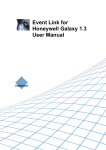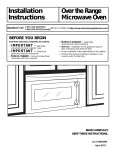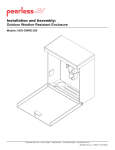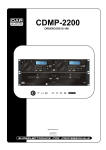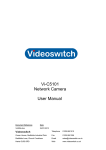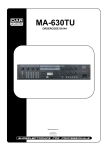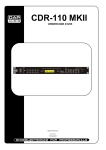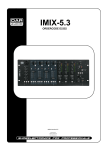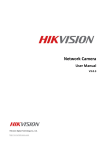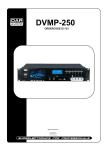Download DAPAudio M9000 Product guide
Transcript
CDMP-150 ORDERCODE D1152 Highlite International B.V. Vestastraat 2 6468 EX Kerkrade The Netherlands Congratulations! You have bought a great, innovative product from DAP Audio. The DAP Audio CDMP-150 brings excitement to any venue. Whether you want simple plug-&-play action or a sophisticated show, this product provides the effect you need. You can rely on DAP Audio, for more excellent audio products. We design and manufacture professional audio equipment for the entertainment industry. New products are being launched regularly. We work hard to keep you, our customer, satisfied. For more information: [email protected] You can get some of the best quality, best priced products on the market from DAP Audio. So next time, turn to DAP Audio for more great audio equipment. Always get the best -- with DAP Audio ! Thank you! 1 DAP Audio DAP Audio CDMP-150™ Product Guide Warning ........................................................................................................................................................................... 3 Unpacking Instructions ............................................................................................................................................. 3 Safety Instructions ..................................................................................................................................................... 3 Operating Determinations ....................................................................................................................................... 4 Return Procedure ...................................................................................................................................................... 5 Claims ......................................................................................................................................................................... 5 Description of the device ............................................................................................................................................. 6 Overview .................................................................................................................................................................... 6 Front ............................................................................................................................................................................ 7 Installation ...................................................................................................................................................................... 9 Set Up and Operation ................................................................................................................................................... 9 Names and functions .................................................................................................................................................... 9 Operations .................................................................................................................................................................... 12 CD’s/ MP3-discs/ USB sticks/ SD- MMC cards ..................................................................................................... 12 Starting playback .................................................................................................................................................... 12 Stop playback ......................................................................................................................................................... 12 Selecting tracks ....................................................................................................................................................... 12 Selecting Folders ..................................................................................................................................................... 12 Pausing ..................................................................................................................................................................... 12 Scanning Fast forward ........................................................................................................................................... 13 Scanning Fast backwards ..................................................................................................................................... 13 Setting a cue point ................................................................................................................................................. 13 Cueing ...................................................................................................................................................................... 13 Repeat mode .......................................................................................................................................................... 13 Time display.............................................................................................................................................................. 13 Changing pitch of the song .................................................................................................................................. 13 Loop play ................................................................................................................................................................. 14 Reloop....................................................................................................................................................................... 14 Program play ........................................................................................................................................................... 14 Before switching off the power .................................................................................................................................. 14 Maintenance ................................................................................................................................................................ 15 Troubleshooting ........................................................................................................................................................... 15 Product Specification.................................................................................................................................................. 16 2 Warning FOR YOUR OWN SAFETY, PLEASE READ THIS USER MANUAL CAREFULLY BEFORE YOUR INITIAL START-UP! Unpacking Instructions Immediately upon receiving this product, carefully unpack the carton and check the contents to ensure that all parts are present, and have been received in good condition. Notify the dealer immediately and retain packing material for inspection if any parts appear damaged from shipping or the carton itself shows signs of mishandling. Save the carton and all packing materials. In the event that a device must be returned to the factory, it is important that the device is returned in the original factory box and packing. Your shipment includes: • DAP CDMP-150 • Stereo RCA cable 1,2m • Power cable 1,5m • User manual CAUTION! Keep this system away from rain and moisture! Safety Instructions Every person involved with the installation, operation and maintenance of this system has to: be qualified follow the instructions of this manual CAUTION! Be careful with your operations. With a dangerous voltage you can suffer a dangerous electric shock when touching the wires! Before you initial start-up, please make sure that there is no damage caused by transportation. Should there be any, consult your dealer and do not use the system. To maintain perfect condition and to ensure a safe operation, it is absolutely necessary for the user to follow the safety instructions and warning notes written in this manual. Please consider that damages caused by manual modifications to the system are not subject to warranty. This system contains no user-serviceable parts. Refer servicing to qualified technicians only. IMPORTANT: The manufacturer will not accept liability for any resulting damages caused by the nonobservance of this manual or any unauthorized modification to the system. Never let the power-cord come into contact with other cables! Handle the power-cord and all connections with the mains with particular caution! Never remove warning or informative labels from the unit. Never use anything to cover the ground contact. Never leave any cables lying around. 3 Do not insert objects into air vents. Do not connect this device to a dimmerpack. Do not switch the device on and off in short intervals, as this would reduce the system’s life. Do not open the device and do not modify the device. Only use system indoor, avoid contact with water or other liquids. Avoid flames and do not put close to flammable liquids or gases. Always disconnect power from the mains, when the system is not used. Only handle the powercord by the plug. Never pull out the plug by tugging the power-cord. Make sure you don’t use the wrong kind of cables or defective cables. Make sure that the available voltage is not higher than stated on the rear panel. Make sure that the power-cord is never crimped or damaged. Check the device and the powercord from time to time. Please turn off the power switch, when changing the power cord or signal cable. If the device is dropped or struck, disconnect mains power supply immediately. Have a qualified engineer inspect for safety before operating. If the device has been exposed to drastic temperature fluctuation (e.g. after transportation), do not switch it on immediately. The arising condensation water might damage your system. Leave the device switched off until it has reached room temperature. If your Dap Audio device fails to work properly, discontinue use immediately. Pack the unit securely (preferably in the original packing material), and return it to your Dap Audio dealer for service. Repairs, servicing and electric connection must be carried out by a qualified technician. WARRANTY: Till one year after date of purchase. Operating Determinations This system is not designed for permanent operation. Consistent operation breaks will ensure that the system will serve you for a long time without defects. If this system is operated in any other way, than the one described in this manual, the product may suffer damages and the warranty becomes void. Any other operation may lead to dangers like short-circuit, burns, electric shock, etc. You endanger your own safety and the safety of others! Improper installation can cause serious damage to people and property ! Connection with the mains Connect the device to the mains with the power-plug. Always pay attention, that the right color cable is connected to the right place. International L N EU (including UK) From April 2004 Brown Blue Green/Yellow North America Pin Black White Green Phase Neutral Protective Earth Make sure that the device is always connected properly to earth! 4 Return Procedure Returned merchandise must be sent prepaid and in the original packing, call tags will not be issued. Package must be clearly labeled with a Return Authorization Number (RMA number). Products returned without an RMA number will be refused. Highlite will not accept the returned goods or any responsibility. Call Highlite 0031-455667723 or mail [email protected] and request an RMA prior to shipping the device. Be prepared to provide the model number, serial number and a brief description of the cause for the return. Be sure to properly pack the device, any shipping damage resulting from inadequate packaging is the customer’s responsibility. Highlite reserves the right to use its own discretion to repair or replace product(s). As a suggestion, proper UPS packing or double-boxing is always a safe method to use. Note: If you are given an RMA number, please include the following information on a piece of paper inside the box: 1) Your name 2) Your address 3) Your phone number 4) A brief description of the symptoms Claims The client has the obligation to check the delivered goods immediately upon delivery for any shortcomings and/or visible defects, or perform this check after our announcement that the goods are at their disposal. Damage incurred in shipping is the responsibility of the shipper; therefore the damage must be reported to the carrier upon receipt of merchandise. It is the customer's responsibility to notify and submit claims with the shipper in the event that a fixture is damaged due to shipping. Transportation damage has to be reported to us within one day after receipt of the delivery. Any return shipment has to be made post-paid at all times. Return shipments must be accompanied with a letter defining the reason for return shipment. Non-prepaid return shipments will be refused, unless otherwise agreed in writing. Complaints against us must be made known in writing or by fax within 10 working days after receipt of the invoice. After this period complaints will not be handled anymore. Complaints will only then be considered if the client has so far complied with all parts of the agreement, regardless of the agreement of which the obligation is resulting. 5 Description of the device Features The CDMP-150 is a professional 1U CD/USB/MP3 player from DAP Audio. • • • • • • • LCD display with blue backlight Pitch control +/- 16% Electronic anti shock buffer (40 seconds) Seamless loop function Cue function Program function USB stick/hard disk port Overview 6 Front Fig. 1 1. Power switch 2. Disc slot 3. Eject buton 4. LCD Display 5. Track select encoder 6. Rewind button 7. Fast forward button 8. Loop in button + LED 9. Out button 10. Reloop button 11. Pitch control 12. CD load LED 13. USB jack 14. CD/USB button 15. IR sensor 16. Cue button 17. Play/pause button 18. Repeat button 19. Single button 20. Time button 21. Pitch – button 22. Pitch button 23. Pitch + button Back Fig. 2 24. Phones level control 25. Phones output 26. Balanced line out L/R 27. Unbalanced Line out L/R 28. Power entrance 7 Remote control Fig. 2 29. Cursor left button 30. Cursor up button 31. Cursor right button 32. Power button 33. Repeat button 34. OK button 35. Time button 36. Cue button 37. Play/pause button 38. Rewind button 39. Pitch – button 40. Pitch button 41. Direct acces buttons 42. Eject buton 43. PGM button 44. Cursor down button 45. S/C button 46. Folder button 47. Fast forward button 48. Skip button 49. Pitch bend + button 50. Reloop button 51. Source button 52. Pitch + button 53. Loop in button 54. Loop out button 55. Pitch bend - button 56. Skip button 8 Installation Remove all packing materials from the CD Player. Check that all foam and plastic padding is removed. Connect all cables. Always disconnect from electric mains power supply before cleaning or servicing. Damages caused by non-observance are not subject to warranty. Set Up and Operation Before plugging the unit in, always make sure that the power supply matches the product specification voltage. The power supply is printed on the back of the device. Do not attempt to operate a 120V specification product on 230V power, or vice versa. Connections 1. Turn off the power (1) switch. 2. Connect the line out L/R (28 or 25/26) outputs to the input of your mixer. Caution: Be sure that the power is off, when connecting the cables. Names and functions Below is a description of the functions of the controls. 1. Power switch This is the main power switch. Push to turn the device on. 2. Disc slot Place the disc gently in the slot. The disk will load automatically. Stop playback and press the eject (3/44) button to eject the disk. 3/42. Eject button Use this button to eject the disc. The disc can’t be ejected during Playback. Pause playback before pushing the eject button. 4. LCD Display 5. Track select encoder Dialing the encoder clockwise, allows you to skip a track forwards, dialing counterclockwise will skip a track backwards. Pushing the encoder when in playback mode, allows you to skip 10 tracks forwards or backwards. Pushing and holding while dialing the encoder, allows you to select a folder when in MP-3 mode. 6/38. Search button Push and hold this button to play the track fast backwards. 7/47. Search button Press and hold this button to play the track fast forward. 8/53. Loop in button The loop in button allows you to set the start point for the loop. 9/54. Loop out button The loop out button allows you to set the end point for the loop. Pushing the button again, allows you to exit the loop. 10/50. Reloop button Use this button to start the last saved Loop. Push the loop out (9/54) button to exit the loop playback. 9 11. Pitch control encoder Use this encoder to adjust the playback speed. Dial the control counterclockwise to slowdown the playback speed, dial the control to speedup the pklayback speed. 12. CD load LED This LED blinks while loading the CD. 13. USB port Use this port to connect a USB stick or an external hard disk. The USB port is only active when you’re in USB mode. Note: The CDMP-150 recognizes FAT and NTFS format up to a maximum capacity of 16 Gb, 99 folders and 999 files. 14/51. CD/USB (source) button Use this button to select CD or USB mode. 15. IR sensor This sensor receives the information of the remote control. Don’t place any object or sticker in front of the sensor. 16/36. Cue button Push this button during playback to return to the position of the last cue point. 17/37. Play/pause button This button allows you to toggle between pause mode and playback mode. 18/33. Repeat button Use this button to repeat one track or all tracks of the medium. See the section Repeat mode on page 13. 19/45. Single (S/C) button Use this button to switch between the single play mode and continuous play mode. The selected mode is indicated by Single or Cont. in the LCD display (4). In single play mode, the unit stops playing after each track. In continuous play mode, the unit plays all tracks and then stops. 20/35. Time button Use this button to switch the TIME indication in the LCD display (4) between the elapsed time and remaining time. The selected mode is indicated by ELAPSED or REMAIN. 21/55. Pitch bend – button The playback slows down while pushing and holding this button. Release the button to return to the original BPM. Make sure pitch bend mode is activated by pushing the pitch (22/40) button. 22/40. Pitch button This button allows you to toggle the pitch mode on or off. In pitch mode, you are able to use the pitch bend + (23/52) and pitch bend – (21/55) buttons. Pitch mode will be indicated in the LCD display (4). 23/49. Pitch bend + button The playback speeds up while pushing and holding this button. Release the button to return to the original BPM. Make sure pitch bend mode is activated by pushing the pitch (22/40) button. 24. Phones level control Is used to adjust the volume level of the phones (25) output. 10 25. Phones output You can connect a pair of headphones with an impedance of 32 - 600 Ohm to the headphones connector. It is a 6,3mm (1/4”) TRS socket, wired as Tip=left, Ring=right and sleeve = ground. 26. Balanced line out L/R XLR stereo line output. Use these outputs to connect to a mixer with balanced XLR inputs. 27. Unbalanced line out L/R RCA stereo line output. Use these outputs to connect to a mixer with unbalanced RCA inputs. 28. AC power entrance This connector is meant for the connection of the supplied main cord. Connect one end of the power cord to the connector, the other end to the mains, then turn on the power switch to operate the unit. 29. Cursor left button Not functional in combination with the CDMP-150. 30. Cursor up button Not functional in combination with the CDMP-150. 31. Cursor right button Not functional in combination with the CDMP-150. 32. Power button Not functional in combination with the CDMP-150. 34. OK button Not functional in combination with the CDMP-150. 39. Pitch – button Push this button to slow down the playback speed. 41. Direct access buttons When selecting radio stations stored in memory you can use the +10 button to move up 10 presets. E.g. if your actual preset is 5, pressing the +10 button will select Preset 15. 43. PGM button Stop playback and press the PGM button, the player will enter the program mode. For more information, see the section Program play on page 14. 44. Cursor down button Not functional in combination with the CDMP-150. 46. Folder button Push this button to select a folder while in MP-3 mode. 48. Skip button Press this button to skip to the next track. 52. Pitch + button Push this button to speed up the playback speed. 56. Skip button Press this button to go back to the beginning of the current track or select a previous track for playing. 11 Operations Loading a CD Hold the disc by the edges and push it gently in the disc slot (39). The Disc will now be loaded automatically. Unloading CD’s 1. The disc can't be ejected during playback. Stop the playback first. 2. Press the eject (3/42) button. The disc will be ejected. 3. If the movement of the disc stops, take the disc by the edges and remove it completely from the slot. Caution: • Do not place any foreign objects in the disc slot and do not try to place more than one disc in the disc slot at a time. • Do not push the disc in manually when the power is off, as this may result in malfunction and may damage the player. CD’s/ MP3-discs/ USB sticks/ SD- MMC cards MP3 is an audio compression mode using level 3 of the international MPEG standard, whereby the sound signal is compressed at the ratio of 12:1. An MP3 disc can record music for playback over 600 minutes or record over 170 songs in a sound quality that fully matches the sound quality of CD’s. An USB stick can record even more. Obviously the CDMP-150 works also with normal audio CD’s. Starting playback • Push the play/pause (17/37) button during the pause mode or cue mode to start playback. While in playback mode, the LED in the play/pause (17/37) button lights up green. • If the search buttons are used during pause mode, the point at which playback starts is automatically stored in the memory as the cue point. The CD Player returns to the cue point when the cue (16/36) button is pressed. Stop playback There are two ways to stop playback: • Push the play/ pause (17/37) button while in playback mode to pause at that point. • Push the cue (16/36) button during playback to return to the cue point and enter pause mode. Selecting tracks • Dial the track (5) encoder clockwise to move to a higher track number. • Dial the track (5) encoder counterclockwise to move to a lower track number. • When a new track is selected during playback, playback begins as soon as the skip search operation is completed. • If you dial the track (5) encoder clockwise while at the last track, the first track will be selected. In the same way, if you dial the track (5) encoder counterclockwise while at the first track, the last track will be selected. • Pushing the track (5) encoder while playing CD’s, allows you to skip 10 tracks forwards or backwards. Selecting Folders • In pause mode: Push the folder (46) button to select a folder. • In Program mode: Push the folder (46) button to select a folder. • In USB mode: Pushing the folder (46) button will skip the current file and start playing the next folder’s first file. • In USB mode: Pushing dialing the track (5) button at the same time, allows you to select a folder. Pausing • Push the play/pause (17/37) button to switch between playback mode and pause mode. • The LED in the play/pause (17/37) button will blink while the unit is in pause mode. • Playback resumes when the play/pause (17/37) button is pushed again. 12 Scanning Fast forward • Forward Scanning is a function for moving quickly forwards while being in playback mode. • While pressing and holding the search (7/47) button for more than 1 second, the disc moves rapidly forward and the sound is audible. The current scan point is indicated on the LCD. Scanning Fast backwards • Backward Scanning is a function for moving quickly backwards while being in Playback mode. • While pressing and holding the search (6/38) button for more than 1 second, the disc moves rapidly backwards and the sound is audible. The current scan point is indicated on the LCD. Setting a cue point • Push the play/pause (17/37) button to toggle between play mode and pause mode. • The play/pause (17/37) button and the cue (16/36) button will flash when the unit is in pause mode. • Use the search (6/38) and/or search (7/47) buttons to cue modeIn go to your desired cue point (is necessary). • Push the play/pause (17/37) button again and your cue point has been stored and playback will continue. Cueing Cueing is the action of preparing for playback. • Push the cue (16/36) button, the player will enter the cue mode, the playback returns to the cue point and enters pause mode condition, the LED in the play/pause (17/37) button will blink. Pushing the play/pause (17/37) button will start playback from the cue point. Repeat mode Two different repeat modes are available: REPEAT 1 and REPEAT ALL. When you press repeat (18, 33) during playback, you can choose between the following play modes: 1. REPEAT 1: Repeats a single track several times. 2. REPEAT ALL: Repeats all tracks several times. Time display Pushing the time (20/35) button to select between 3 time modes: 1. Elapsed time of a track (ELAPSED). 2. Remaining time of a track (REMAIN). 3. Remaining time of the disc (TOTAL REMAIN). This display mode can only be activated if a disc is formatted as a CD. Changing pitch of the song There are three tools available for matching the BPM of the CD: • Use the pitch encoder to adjust the BPM. 1. Adjust the BPM by dialing the pitch encoder (11) up or down. 2. Dial the pitch encoder (11) counterclockwise to decrease BPM, or clockwise to increase BPM. The adjustment range is +/- 16%. • Use the pitch bend buttons to change the BPM temporarily. 1. The BPM increases or decreases respectively while the pushing the pitch bend + (23/49) of pitch bend – (31) button. 2. The BPM increase depends on how long you hold the button. If you hold the button for about 5 seconds, the BPM will go + 16% for pitch bend + (23/49) or - 16% for pitch bend – (21/55). If you tap the button, the BPM will only change a little so you can change the beat slightly without an audible change in the music. 3. The CD will return to the BPM set with the pitch encoder (11) when you release the pitch bend + (30) and pitch bend – (21/55) buttons. 13 Loop play 1. Push the loop in (8/53) button to set the loop start point, the LED beneath the loop in (8/53) button will light up, indicating that the start point is memorized. 2. Push the loop out (9/54) button to set the loop end point. The LED beneath the button will light up also. As soon as the end point is set, the playback will start loop play from start point to end point repeatedly. Both the LEDs beneath loop in (8/53) and loop out (9/54) buttons will light and LOOP will appear in the LCD display. 3. Pushing the loop out (9/54) button will cancel the loop play function, the LOOP indication in the LCD display (13) will disappear and the LED beneat the loop out (9/54) button will dim. 4. The only way to erase a loop is to record a new loop. Reloop 1. If you press the reloop (10/50) button, the disc will return to loop playback. 2. Push the loop in (8/53) button over and over rapidly to start the loop again and again. 3. Push the loop out (9/54) button, the loop play function is canceled, the LOOP indication in the LCD display (13) will disappear. Program play 1. Push the play/pause (17/37) button to enter pause mode. 2. Push the pgm (43) button, the player will enter program mode, indicated by PROGRAM blinking in the LCD (13) display. 3. Only in MP-3 mode: Select a folder by pushing the folder (46) button. 4. Select a track by either pushing the direct access (41) buttons or by dialing the track (5) encoder. 5. Push the pgm (43) button to store the selected track in the program sequence. 6. Repeat step 3 to 5. A maximum of 99 tracks can be programmed. 7. Use the play/pause (17/37) button to start or pause program play. 8. To exit program play, enter pause mode by pushing the play/pause (17/37) button and push the pgm (43) button. 9. To erase a program, push and hold the pgm (43) button more than 3 seconds. The PROGRAM indication in the display will disappear. Before switching off the power CAUTION: Do not force the disc in when the power is switched off. Do not switch off the power, when the disc is ejecting. Switch off the power after the disc has been ejected. CD’s 1. Precautions on handling compact discs • Do not allow fingerprints, oil or dust to get on the surface of the disc. If the disc is dirty, wipe it off with a soft dry cloth. • Do not use thinner, water, record spray, electrostatic-proof chemicals, or silicone-treated cloths to clean discs. • Always handle discs carefully to prevent damaging the surface; in particular when removing a disc from its case or returning it. • Do not bend the disc. • Do not put the CD near heating sources. • Do not enlarge the hole in the center of the disc. • Do not write on the label (printed side) with a hard-tipped implement such as a pencil or ball point pen. • Condensation will form if a disc is brought into a warm area from a colder one, such as outdoors in winter. Do not attempt to dry the disc with a hair dryer, etc. 2. Precaution on storage • After playing a disc, always unload it from the player. • Always store the disc in the jewel case to protect from dirt or damage. • Do not place discs in the following areas: 1. Areas exposed to face sunlight for a considerable time. 2. Areas subject to accumulation of dust or high humidity. 14 3. Areas that are affected by heat from indoor heaters, etc. Maintenance The DAP Audio-CD-Player CDMP-150 requires almost no maintenance. However, you should keep the unit clean. Disconnect the mains power supply, and then wipe the cover with a damp cloth. Do not immerse in liquid. Do not use alcohol or solvents. Keep connections clean. Disconnect electric power, and then wipe the audio connections with a damp cloth. Make sure connections are thoroughly dry before linking equipment or supplying electric power. Troubleshooting DAP Audio-CD-Player CDMP-150 This troubleshooting guide is meant to help solve simple problems. If a problem occurs, carry out the steps below in sequence until a solution is found. Once the unit operates properly, do not carry out following steps. 1. If the device does not operate properly, unplug the device. 2. Check power from the wall, all cables, connections, etc. 3. If all of the above appears to be O.K., plug the unit in again. 4. If nothing happens after 30 seconds, unplug the device. 5. Return the device to your DAP Audio dealer. 15 Product Specification Pitch: Pitch bend: Loop: S/N ratio: Freq response (-3dB): Compatible disks: USB files: USB format: Anti-shock buffer: Remote batteries: Power supply: Power consumption: Dimensions: Weight: 16% 16% Seamless 96 dB 20 – 20Khz CD, CDR, CDRW, Audio & Data (MP3 files) MP3, max 99 folder, 999 files FAT, NTFS max 16Gb 40 Sec 2x AAA (not included) 100-240V 50/60Hz 16W 483 x 225 x 44 (WxDxH) 2.9 Kg Design and product specifications are subject to change without prior notice. Website: www.Dap-audio.info Email: [email protected] 16 2013 Dap Audio.


















